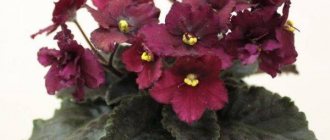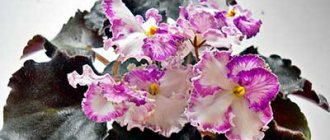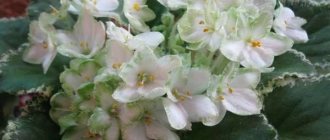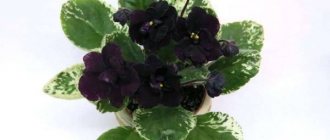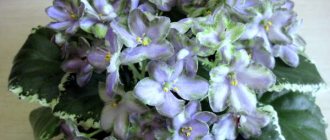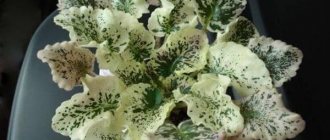The first work to improve the varietal characteristics and decorative properties of violets began in America almost immediately after the appearance of tropical beauties at world flower exhibitions.
Scientific developments were carried out not only in numerous, newly created schools of selection of Uzambara violets, but also by private masters of variety transformation.
Among the most popular and sought-after Saintpaulia violet growing community members of the world are the varieties of the “Buckeye” line , which are distinguished by rosettes with very symmetrical contours, excellent flowering and relatively simple care methods.
Violet Kentucky Baby Bells
Excellent violet Kentucky Baby Bells.
The author of the variety is D. Rollins. Above is a photo of a Kentucky Baby Bells violet. The description of the variety states that these are white bells with a delicate pink eye and imprints. Foliage:
- Saturated;
- Green;
- With white variegation.
The variety is classified as miniature .
The miniature variety is easy to grow.
Saintpaulia is not the most difficult to grow , but it reacts very clearly to temperature changes. According to the description, the flowers should be white with pink prints. But in extreme heat they turn almost pink.
If there is a need to grow a violet for an exhibition, then the outlet is placed in a room with a constantly running air conditioner . The bell should remain half open.
Saintpaulia needs moist indoor air.
It reproduces well and can be easily grown from leaf cuttings . The variety takes root well and produces several children. The rosette is formed smoothly and does not create any special problems. Sometimes there are specimens with particularly pronounced variegation; such plants are of particular value.
The rosette of this variety is very miniature and even.
Varietal characteristics are transferred well, but it can give sports . They appear as a lack of variegation, pink bells or semi-double flowers.
Attention! Sometimes there is pink variegation on the leaves. This indicates that the rosette will produce dark pink flowers instead of white ones.
This variety has a sport.
Features of flowering, growth and reproduction
The rosette is very beautiful , even if there are no flowers on it. There are a lot of white areas on the leaves.
In order to grow a full-fledged plant from a cutting, it will take at least 12 months . The Kentucky Baby Bells violet, like all varieties with pronounced variegation, develops very slowly.
Saintpaulia grows and develops very slowly.
In order to grow this plant, it is worth taking cuttings with a lot of green color. It is also very important to wait until the babies turn green before separating them from the mother leaf. If the baby's leaves are completely white and have no greenery, then photosynthesis processes will become impossible. Kids like this:
- They die;
- Or they develop very slowly.
Saintpaulia Kentucky Baby Bells is most often propagated from leaf cuttings. Varietal characteristics are conveyed well. The mutation most often appears as semi-doubleness or darkening.
Violet can also be propagated by lateral stepsons . But before separating the sprout from the stem, you should wait for green areas to appear on the leaf blades. The more there are, the faster the young rosette will develop.
The variety reproduces well by leaf.
The variety is sensitive to heat. At high temperatures, the flowers change from white with pink markings to completely pink. Pink color may also appear on the leaves. Peduncles:
- Tall;
- Sturdy;
- They hold flowers well in weight.
Each of them can have up to seven buds. It blooms long and profusely, constantly producing new flower stalks. Cap flowering is not difficult to achieve.
Reviews about violet
Alexandra, Moscow: “You cannot expect that the first flowering will be perfect. If the buds were planted in the heat, then the pink color is guaranteed. Before throwing away or donating a rosette, you should wait for the second flowering.”
Svetlana, Cherepovets: “I bought a baby of this variety. Develops slowly. Pink areas appeared on the leaves. I can’t tell if it’s a sport or if she’s lacking nutrients. I’ll wait for the flowering.”
Varietal violets Aca's Eloise, N-Antoshka, Jolly Orchid and others
Dear friends, the last month of summer has arrived, and I congratulate you all! Time flies at great speed...
Today I will show you my blooming miniatures. I've already shown some.
Violet Aca's Eloise, Brownlie, semi-mini:
A small rosette with large up to 4 cm white flowers with a crimson eye and a thin border along the edge of the petals. Blooms readily and for a long time. This rosette after re-rooting has almost no leaves, but the bouquet is wonderful.
Violet N-Antoshka, Berdnikova, mini:
Delicate pink bell-shaped flowers with abundant crimson fantasy. A very beautiful variegated rosette. Flowering is frequent and abundant. The flowers last a long time, although they are “fallen”.
Violet Jolly Orchid, Pittman, mini:
In these 2 photos, the rosette blooms for about 2 months:
During this time, I removed only a few wilted flowers.
This is the middle of flowering:
Closer flowers:
The variety is wonderful! It was registered in 2007. White double and semi-double flowers with a blue eye and a light green variable border. Flowers are 2 - 2.5 cm, but there are a lot of them. There are from 3 to 8 flowers on one peduncle. New flower stalks are constantly appearing. A bouquet of flowers covers almost the entire rosette. This rosette grows on a wick, size - 11 cm. The flowers last a very long time. The rosette is small, with even rows of leaves. The variety is no problem. As the rosettes age, the flowers do not float, as happens with some white flowers with a blue eye (Rob's Penny Ante, Rob's Cotton Ball...), which after 2-3 years have to be re-grown from cuttings.
Violet Rob's Monkeyshines, Robinson, chimera, semi-mini:
I really love this chimera. It blooms often, profusely, the flowers last a long time, although they fall off.
Violet Nibble, Sorano, mini:
The variety is interesting because it has elongated clacamus foliage. Flowers are located on long stalks, 3-5 pieces on each. The flowers are large, up to 4.5 cm, double, pink with a lilac coating on the edges of the petals, and last a very long time. A variety for the patient. When propagating by cuttings, you have to wait a long time, the children grow slowly, the rosette also grows slowly... At a young age it produces many stepsons. But sometimes, after flowering, babies form on the peduncles near the stipules; they can be rooted well. An unusual variety.
Violet Mac's Momentary Meltdown, McDonald, semi-mini:
A constantly flowering variety, it can bloom for six months or more with sufficient lighting:
Violet Toronto Belle, Adams, semi-mini:
The flowers are simple pink with a lilac coating and a crimson eye. The flowers are located on tall branched peduncles, 3-6 pieces on one peduncle. The flowers are quite large, up to 3.5 cm, and when they all bloom, the flower stalks fall onto the rosette, but I even like it.
A beautiful variegated rosette with gel foliage. The leaves are elongated with large scallops, reminiscent of oak leaves.
That's all for today.
Violet Kentucky Baby Sister
Delicate violet Kentucky Baby Sister.
Authorship belongs to D. Rollins . The flowers are white stars, with a slightly wavy green edge and a darkened pink-fuchsia eye. The foliage is dark green with bright white variegation.
The Kentucky Baby Sister violet is considered a miniature, but it is more likely to be classified as a semi miniature . Socket:
- Neat;
- Easy to form.
Variegation is more pronounced in cool conditions . In hot weather, the leaves become greener.
Saintpaulia often produces uneven flowers.
Very often the variety does not produce the most even and beautiful colors. We can say that instead of stars we get krakozyabrs, especially during the first flowering . To be sure of the exact absence of varietal characteristics, it is worth waiting for the second flowering.
Sports varieties appear as an irregular flower shape , lack of white tint on the petals.
Features of growth, flowering and reproduction
The variety feels great at home. Not capricious , grows and develops well.
This variety is very easy to care for.
An adult plant can be grown in 10-12 months . Can be grown both from cuttings and from lateral sprouts. Varietal characteristics are transmitted well, but do not always appear during the first flowering. Most often, deviations appear in the shape of a flower.
The varietal characteristic is a slightly wavy edge. But it often happens that the petals:
- Twisted;
- They don't straighten out;
- They wither and dry up in a semi-dissolved state.
In such cases, it is worth following the fertilizer application schedule , or waiting for re-blooming. For the rosette to show itself in all its glory, you should give it time. This is an individual feature of the variety.
Saintpaulia flower stalks tend to droop from the weight of the flowers.
Peduncles are tall but thin. They often end up on the socket, which ends up looking like a trailer.
In the heat, the pink-fuchsia eye often becomes larger in size , and the violet swims. There are many flower stalks, the rosette produces them constantly. It often blooms with a lush head of flowers.
Attention! The flowering period is long, new buds appear constantly.
Reviews about violet
Elena, St. Petersburg: “My violet has already given its first bloom. The flowers opened well, unlike other greenfinches. But the socket is a little larger than I expected. It can be classified more as a semi-mini than a miniature. But perhaps my pot is just too big and should be replanted.”
Kristina, Moscow: “My violet gave some untidy flowers - at first they stand, and then they begin to fall on the rosette. The shape of the flowers is not the most neat and even. I'm not very happy with this. Although the peephole inside the bud looks very nice. Perhaps, indeed, you should heed the advice and wait until it matures.”
Caring for a plant at home
Miniature violets require the same conditions as regular ones :
- No temperature changes;
- Scattered light;
- Proper watering.
Watering should be done with settled water at room temperature. Wick watering is allowed, but it is best to water from above.
To avoid overwatering, you can fill almost half the pot with sphagnum moss .
Fertilizers are added to water for irrigation . They should not be given more than once or twice a month. Otherwise, the miniatures grow greatly, and the beautiful flowers are lost against the background of the foliage. Overfeeding with nitrogen manifests itself in the form of a thick and fleshy middle of the leaf blade. If there is too much phosphorus, the leaves begin to turn yellow. If the plant lacks nutrients, the veins begin to turn pale.
During the flowering period, you should increase :
- Degree of illumination;
- And the length of daylight hours artificially.
Also during this period, phosphorus fertilizers begin to be applied .
Violets do not tolerate heat well. This is manifested in the fact that the dark eye, which is located in the center of the flower, begins to creep towards the edge of the petals and the violet floats. This phenomenon occurs even if the rosette formed flower stalks in the heat and blooms in the cool.
Air humidity should be at 55%.
For growing miniature Saintpaulias, standard mixtures are suitable, without excessive amounts of fertilizers and nutrients. It is best to use a lump of sphagnum as drainage for miniatures . This greatly simplifies the process of replanting the plant. It is also very convenient to root in sphagnum:
- Leaf cuttings;
- Or side stepsons.
In miniatures, leaf yellowing is very rarely observed . Such Saintpaulias, provided they are well cared for, can be replanted every few years. They can produce lush flowering even at a very mature age without regular rejuvenation.
Attention! After transplanting into a fresh substrate, the violet can bloom in two months.
Sometimes young rosettes produce lateral stepsons . This is not a consequence of poor care. This phenomenon is a feature of almost all miniature varieties. In this case, it is worth monitoring the formation of lateral growth points and removing them in time.
The lateral stepson can be additionally rooted and a new plant can be obtained. Saintpaulias can also be propagated using leaf cuttings.
Care in indoor culture
Saintpaulias are quite easy to keep indoors if you study a little about the phases of their life, carefully follow care regimens and take into account the known nuances of their growth.
Indoor conditions
The place for violets must certainly be determined taking into account the plant’s relationship to lighting. The varieties listed above prefer to grow on window sills, as they require a lot of light from the natural spectrum.
But when placing a pot of violets on a window, you should remember that the ideal place would be a window sill on the east or west side of the house.
Here a balance will be maintained between the intensity of the lighting and its brightness, which means that the plant will receive everything it needs and will avoid burns from the rays of the luminary.
If there are windows in the room only on the north side, the violet will require additional lighting, and on the south-facing windows the plants will need to be shaded.
Watering and fertilizing mode
The correct watering regime consists of several operations, all of which must be performed:
- visual monitoring of soil drying level;
- the presence of a drainage system in the pot;
- choosing the preferred method of watering - in a pan, with a wick or under the root.
Due to the small volume of the flowerpot and frequent, lush flowering, Saintpaulias require additional nutrition by applying fertilizers. When fertilizing, you should control the percentage of chemical elements in the fertilizer in accordance with the life phase of the plant.
Violets need additional nutrition.
CAREFULLY! For variegated varieties, the nitrogen coefficient is especially important, which is responsible for the production of chlorophyll and can destroy the variegated leaf pattern.
Light level control
For Buckeye Blushing and Buckley's Spoon violets, the illumination of the room plays a paramount role , since they love prolonged exposure to natural light and react negatively to its lack: they hug the flowerpot with drooping leaves and lose their variegation.
Too bright light when backlighting lamps are placed close together can disrupt the fantasy patterns of flowers and the variegated color of leaves until they disappear.
Temperature
Violets develop well when temperatures are consistently maintained within the range of +20 + 24°C . A decrease in these values by 2 - 3 degrees is acceptable in winter and when violets are blooming.
A cool microclimate helps maintain the decorative appearance of the variegated variety and the correct placement of the folding edge of the original semi-miniature leaves.
In any situation, violets must be protected from drafts and sudden changes in temperature.
Effect of air humidity
For Saintpaulias, the air of ordinary apartments is a little dry, so to increase humidity, you should use various types of humidifiers , as well as periodic spraying of the air within the reach of the plant.
Soil requirements
The substrate for Saintpaulia requires light, nutritious, with an optimal content of macro- and microelements, permeable and with good aeration . It is recommended to add activated carbon and particles of drainage materials directly into the soil.
ADVICE! The positive properties of the substrate will last longer if the drainage system in the flowerpot is properly installed.
Pruning and hygiene
During their life, violets only need preventive cleaning in order to maintain plant hygiene. In this case the following are cut off:
- old, damaged or diseased areas of the plant;
- wilted flowers;
- shoots and healthy leaves that thicken the rosette and interfere with the proportional development of the violet.
From time to time, violets need hygienic pruning.
Transplant rules, rejuvenation
Young specimens of Saintpaulia are usually replanted once a year, while older specimens are replanted as needed when visually identified.
Before the procedure, preparatory operations must be carried out:
- preparing a plastic pot of suitable diameter;
- purchasing fresh, enriched soil from the store;
- installation of a drainage system in a flowerpot.
The purpose of violet transplantation determines the method that will be optimal for a particular case:
- if this is a planned procedure for the purpose of replacing a flowerpot , then a more gentle method of transshipment should be preferred;
- in case of suspected diseases of the root system, a transplant will be required, replacing the soil mixture and examining the roots.
Rejuvenation of the plant is carried out by separating the upper, healthy part of the violet from the aged specimen and then rooting it.
The operation is advisable after about five years of violet growing in indoor culture. Preservation of varietal qualities during rejuvenation is guaranteed.

